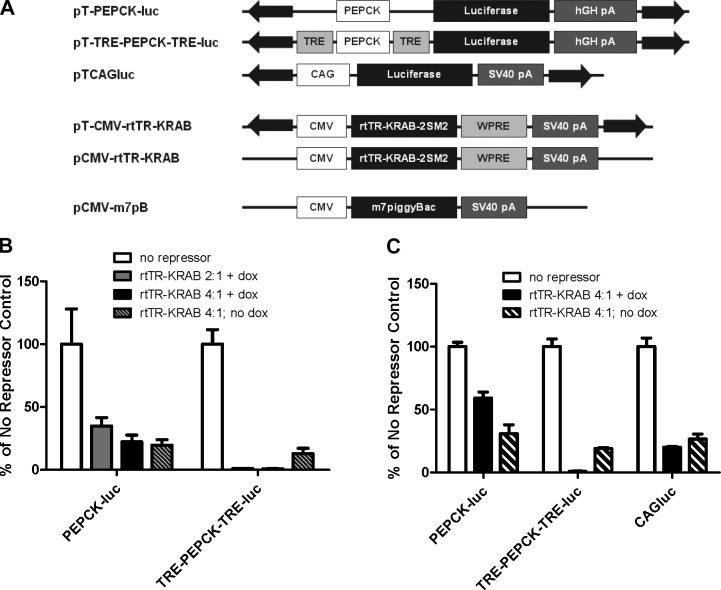Figure 1.
In vitro gene repression by rtTR-KRAB as a 2-part nonviral system. A) Plasmid constructs used in this study. Liver-specific luciferase reporter constructs without (pT-PEPCK-luc) and with (pT-TRE-PEPCK-TRE-luc) Tet-regulatable elements, constitutive luciferase piggyBac transposon plasmid (pTCAGluc); Tet-off repressor expression constructs in a piggyBac transposon (pT-CMV-rtTR-KRAB) and nonintegrating vector (pCMV-rtTRKRAB); hyperactive piggyBac transposase expression plasmid (pCMV-m7pB). CMV, cytomegalovirus immediate early promoter; PEPCK, phosphoenolpyruvate carboxykinase promoter; WPRE, woodchuck hepatitis virus post-transcriptional regulatory element; SV40 pA, simian virus 40 polyadenylation signal; hGH pA, human growth hormone polyadenyaltion signal. B) Comparison of luciferase expression from vectors with no binding site (pT-PEPCK-luc) or 2 binding sites (pT-TRE-PEPCK-TRE-luc for the rtTR-KRAB repressor construct. HeLa cells were transfected with 200 ng of luciferase plasmid and the indicated ratios of rtTR-KRAB transposon plasmid (pT-CMV-rtTR-KRAB). Luciferase activity was assayed 48 h after transfection. While both luciferase constructs showed ∼75% reduction in signal with rtTR-KRAB in the absence of doxycycline, only the construct with binding sites for the repressor (pT-TRE-PEPCK-TRE-luc) had specific repression of expression in the presence of doxycycline (n=3±sd). C) Characterization of nonspecific repression by rtTR-KRAB with different promoters. Cells were transfected with 200 ng of PEPCK promoter-driven luciferase plasmid with or without repressor binding sites or CAG promoter-driven luciferase plasmid (pTCAGluc) in the absence and presence of a 4-fold excess of rtTR-KRAB transposon plasmid. Luciferase activity was assayed 48 h post-transfection (n=3±sd).

